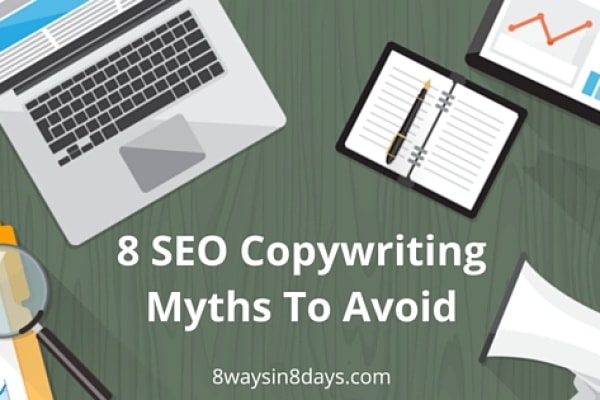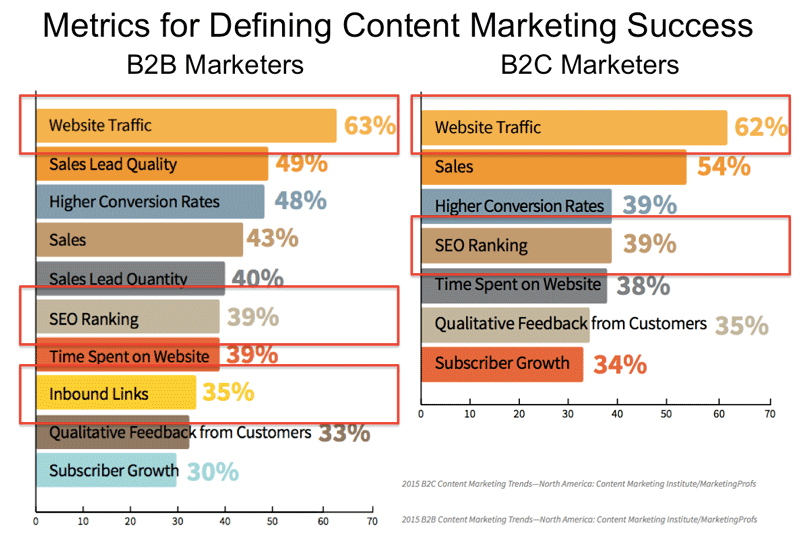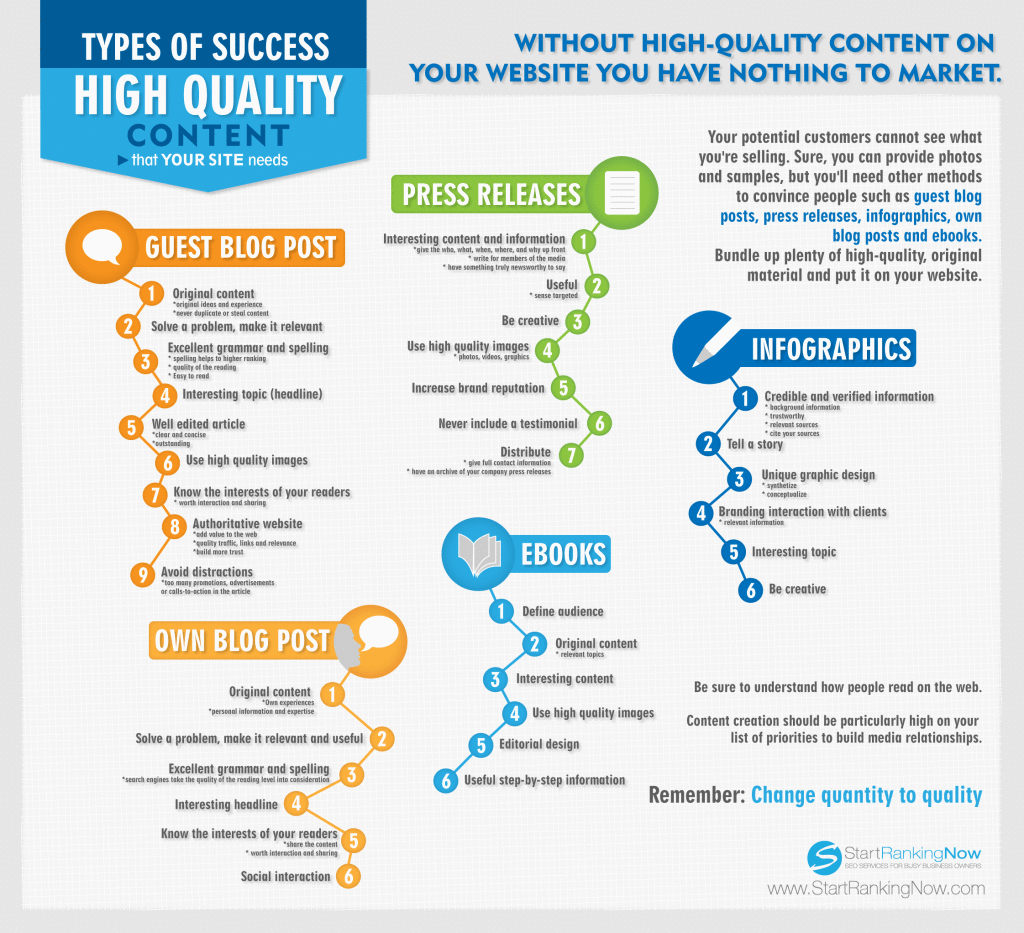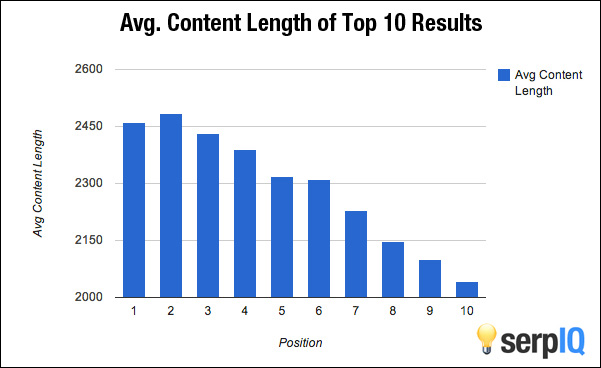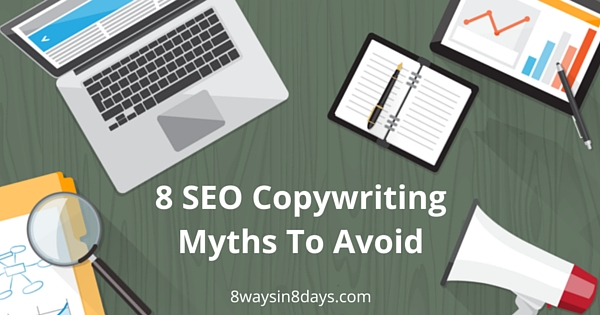
Like the medical field, the business of Search Engine Optimization requires constant vigilance to the latest techniques. Just as you wouldn’t want someone operating on you who hadn’t received any additional training since graduating from medical school decades ago, you wouldn’t want someone writing your copy who has been using the same old tactics and techniques since 1999.
[Tweet “#8Ways your writing has fallen prey to #SEO copywriting myths.”]
In the past, writers were trained in a host of tricks designed to capture search engine attention. The end result was poorly-written pages crammed with nonsensical keyword phrases, link farm pages and text that earned websites top positions but held no value for the reader. Consider this infographic on the history of SEO copywriting created by Express Writers:
Image Source: Visual.ly
Search engine developers have gotten wise to many of the old-school tactics, but not every copywriter has updated his or her style with the times. Part of the reason is that copywriters are often detached from their products. They do the writing, it’s turned over to corporate, and the writer moves onto the next piece, without receiving any feedback. Nowadays, there are ample metrics to measure copywriting success, which should be reviewed periodically to update the company copy policy. Here are a few benchmarks to tally:
Image Source: SearchEngineLand.com
You might like: Top 8 Ways Google’s Pigeon Algorithm Has Changed Local SEO
The Mod Girl Marketing copywriters are continually updated with the latest advances in SEO. We regularly review performance statistics for our clients and develop instructions for our writers that are in-line with creating compelling content for client audiences. Through a content audit, we often identify and correct basic errors that improve search engine rankings in a jiffy. Most of the issues we come across are not so much “bad writing,” but rather, evidence of a dated SEO policy. Here are 8 copywriting myths that are surprisingly pervasive, but need to die once and for all:
1. Keyword density matters.
Five years ago, we were giving our writers instructions based on keyword research. It made sense to connect the copy with the exact search terms people were typing into Google. Keyword density was as high as 10% for longer content or as little as 2%. Special emphasis was placed on titles and headers, the first and last paragraphs, SEO descriptions and and image titles.
Unfortunately, writers were dissatisfied with what people were typing into the search engines. It wasn’t always easy to work a phrase like “home builders Augusta GA” into a paragraph naturally. Repeating long-tail keyword phrases like “best roofing contractors in Kansas City” made the text sound clunky. Likewise, search engines have shifted to prefer more variety and use additional qualifiers for identifying great content.
2. Write natural and don’t bother with keyword research.
Even though keywords and phrases don’t carry the sway they used to, that doesn’t mean they are to be forgotten entirely. Our optimization of content still involves reviewing content and adding a well-integrated key phrase in here and there. We think of it as a pinch of salt added to the copy. We also follow these principles:
– All blogs should be based on value for the audience, not centered on a specific keyword.
– Great articles are so well written they’re quotable and packed with research compiled from outside sources.
– Focusing on creating exceptional content leads to blog subscribers, social sharing, backlinks and conversions.
What makes quality SEO content? Here are a few ideas:
Image Source: Visual.ly
3. Press release anchor text is the best way to get tons of links.
Press releases used to get our clients on the fast track to success. Adding in keyphrase-rich anchor text and syndicating premium releases to the news wires yielded thousands of links and first page results. While many press release wires still come up in the Google news feed and search engine results, guidelines have changed to disallow spammy anchor text. It’s less of an SEO vehicle than it used to be, but the value is not all lost.We still use press releases as a tool for building awareness, attracting major news outlet attention, thought leadership and branding.
4. Inflate the text as much as you can to get better Google rankings.
We remember when the recommendation was “400-500 word minimums for articles,” which later changed to “1,500 word or longer posts.” The end result was copy that repeated itself way too much and provided too little value for readers. It may have been the best decision to make Tolkien’s epic “Lord of the Rings” saga into three separate 3-hour-long films, but critics didn’t feel the same way about “The Hobbit,” which could have easily been one action-packed two-hour movie. By the same token, you don’t want to over-inflate your topic just to reach some arbitrary “magic number.” The general rule of thumb is: Write as much as you have to say and nothing more.
That said, 150-word posts rarely say enough to offer value to a reader. Shorter posts are the role of social media platforms. People digging into blogs want a little more meat-and-potatoes for dinner — not just a side salad. We find that longer posts do tend to get more social shares, allow brands the space to demonstrate expertise and uses more natural keyword combinations that appeal to searchers. You want to find a healthy blend between quick, digestible bits of inspiration and well-researched, in-depth content. If you have trouble crafting the occasional longer post, find someone who can help out.
Image Source: BufferApp.com
5. Cram keywords into headings and headlines.
We still use keywords in H1, H2 and H3 tags — but only if we can work them in naturally and usefully. Using heading tags is still a good practice for online writing, as it breaks up larger chunks of text into manageable sections that allows readers to skim through as they see fit and get an idea as to where your piece is heading. For instance, readers don’t want to read headings like “Best plastic surgeon in Florida” because it doesn’t really tell them what to expect in the subsequent paragraphs; a much better headline would be “How to find the best plastic surgeon in Florida.”
6. Outbound links will only make people leave your site.
An outbound link could send traffic skipping past your blog and onto what they may view as a “more credible source.” If that’s the case, then your writer is simply not creating enough value within the post. We don’t just create posts that parrot another source’s information simply using different words. We compile information from multiple different sources and borrow from our own experiences to deliver a unique product. A truly worthwhile blog should never be afraid to link relevant anchor text to authority sites. Doing so lets search engines know that your main mission is to provide the most relevant and useful information to your readers — not just shamelessly self-promote.
7. Guest posting leads to penalties.
In January of last year, Google’s Matt Cutts scared the crap out of everyone with this post on “the decay and fall of guest posting.” He reported on the abuse of the system, where guest blogging basically turned into paying for PageRank or the publishing of spammy links masquerading as expert opinion. He called out articles about “how to automate guest posting.”
What people missed was the section at the end of Matt Cutts’ post that clarified: ” I’m not trying to throw the baby out with the bath water. There are still many good reasons to do some guest blogging (exposure, branding, increased reach, community, etc.)…. And there are absolutely some fantastic, high-quality guest bloggers out there…. High-quality multi-author blogs like Boing Boing have been around since the beginning of the web, and they can be compelling, wonderful, and useful.”
The take-away is not to cease all guest blogging entirely, but instead to seek out high-quality sites that can share your expertise and help you build your brand.
8. Hiring SEO professionals and copywriters will be too expensive.
Mod Girl Marketing deals with budgets of every shape and size. Most of our clients have rather large marketing budgets, but we’ve worked with entrepreneurs, start-ups and non-profits as well. Quality copy is an attainable investment anyone can make. You don’t need to buy 100 pages of content for your website, 50 premium press releases, 60 blogs per month and an eBook to improve your search ranking, traffic and conversions. Every enterprise is different. We develop a custom package specific to your needs, your industry and your strategic business goals. Hiring a full-time copywriter with the average $55,000 annual salary plus benefits could prove to be costly, but working with a dedicated team of reliable freelancers slashes this figure considerably. Contact us today!

